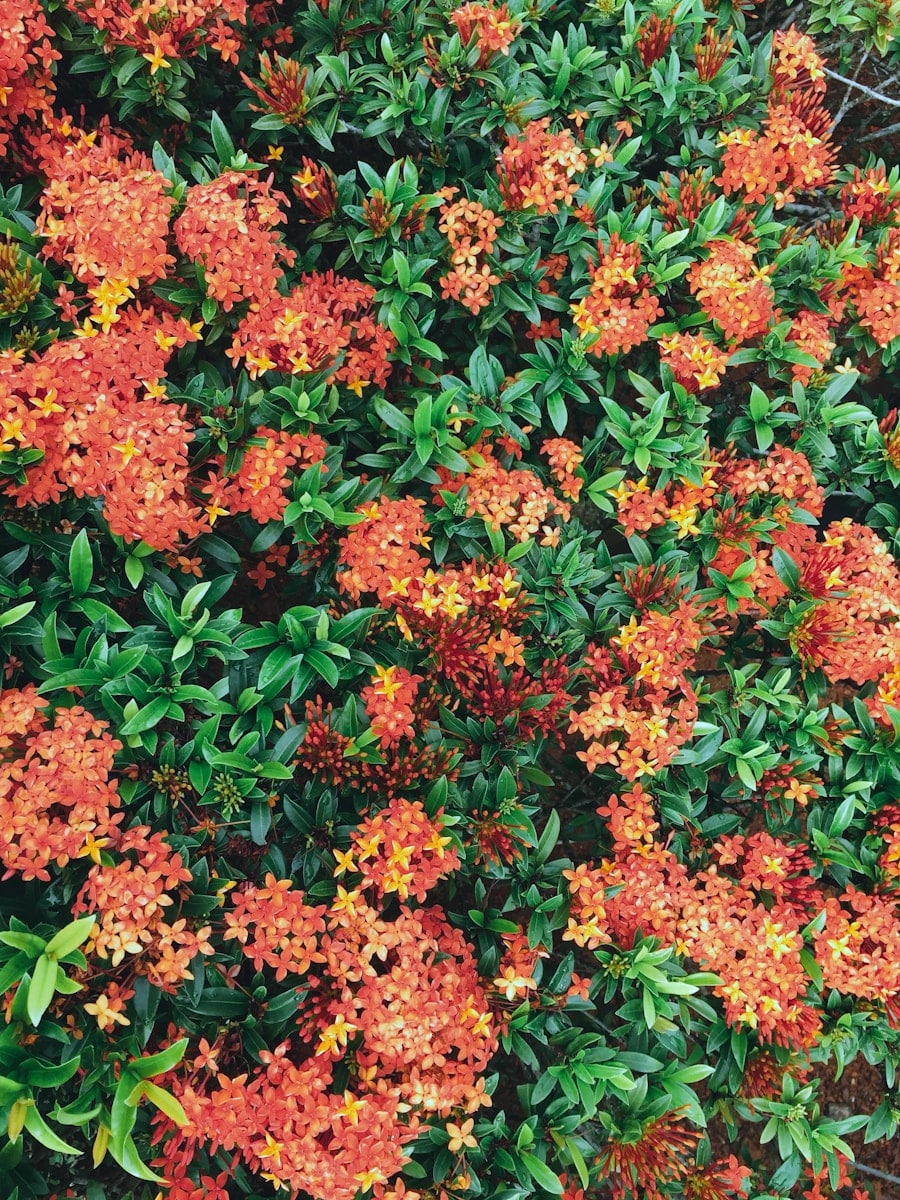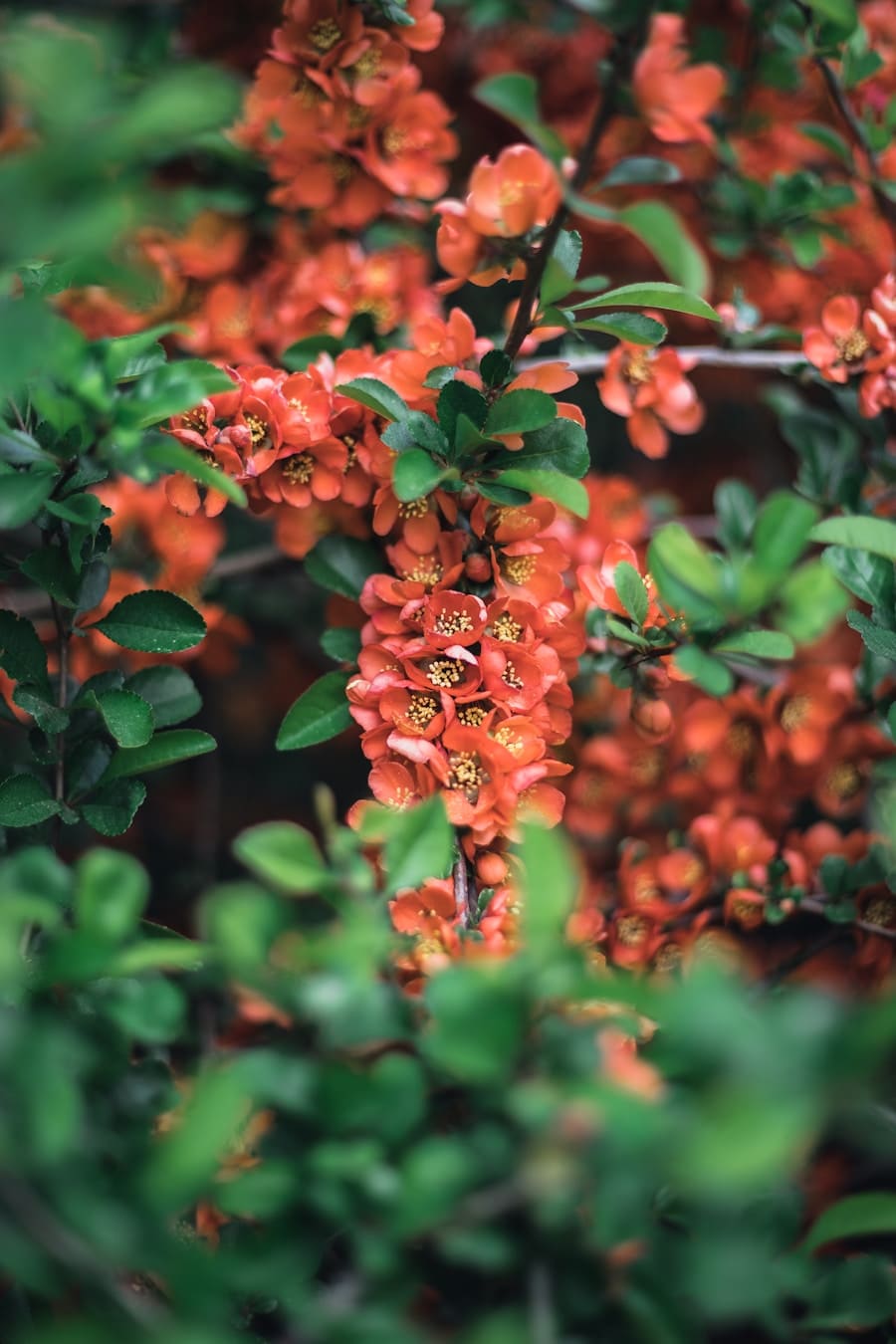There’s something undeniably captivating about orange flowering bushes that draws me in every time I encounter them. Their vibrant hues evoke feelings of warmth and joy, reminiscent of sunrises and sunsets that paint the sky in brilliant shades of orange. As I stroll through gardens or parks, I often find myself pausing to admire these stunning plants, their blossoms swaying gently in the breeze.
The allure of orange flowering bushes lies not only in their striking appearance but also in the emotions they evoke, making them a cherished addition to any landscape. The rich, fiery tones of orange can transform an ordinary garden into a vibrant oasis. I’ve often found that these bushes serve as focal points, capturing attention and sparking conversations among visitors.
Whether it’s the cheerful blooms of a flowering quince or the delicate petals of a marigold bush, each variety brings its unique charm. The sight of these bushes can uplift my spirits, reminding me of the beauty that nature has to offer. It’s no wonder that gardeners and landscape designers alike are drawn to the enchanting presence of orange flowering bushes. Visit Our Site for more information about our products.
Key Takeaways
- Orange flowering bushes add a vibrant and eye-catching element to any garden, making them a popular choice for landscaping.
- There are various types of orange flowering bushes, including azaleas, butterfly bushes, and trumpet vines, each with their own unique characteristics and care requirements.
- Proper care for orange flowering bushes includes regular watering, pruning, and fertilizing to ensure healthy growth and abundant blooms.
- When planting orange flowering bushes in your garden, consider the sunlight, soil, and spacing requirements of the specific type of bush to promote optimal growth.
- Orange flowering bushes can be used in landscaping to create focal points, borders, and hedges, adding a pop of color and visual interest to outdoor spaces.
Types of Orange Flowering Bushes
As I delve deeper into the world of orange flowering bushes, I discover a delightful array of species, each with its own distinct characteristics. One of my favorites is the orange trumpet vine, known for its tubular flowers that attract hummingbirds and butterflies. The vibrant orange blooms cascade down trellises and fences, creating a stunning visual display that never fails to impress me.
Another remarkable option is the orange azalea, which bursts forth in clusters of bright blossoms during the spring months, filling the air with a sweet fragrance that lingers long after the flowers have faded. In addition to these popular choices, I’ve also come across lesser-known varieties like the orange flowering currant. This bush not only boasts beautiful orange flowers but also offers lush green foliage that provides a lovely backdrop throughout the year.
The versatility of these bushes allows me to mix and match different types, creating a dynamic and colorful garden that reflects my personal style. Each type of orange flowering bush brings its own unique flair, making it easy for me to find the perfect fit for my landscape.
How to Care for Orange Flowering Bushes

Caring for orange flowering bushes is an essential aspect of ensuring their health and vibrancy. I’ve learned that proper watering is crucial; these plants thrive in well-drained soil but require consistent moisture, especially during dry spells. I make it a point to check the soil regularly, ensuring it remains damp but not waterlogged.
Additionally, I’ve discovered that fertilizing these bushes with a balanced fertilizer during the growing season can promote lush growth and abundant blooms. Pruning is another vital component of care that I’ve come to appreciate. By removing dead or damaged branches, I can encourage new growth and maintain the bush’s shape.
I typically prune after flowering to avoid cutting off next year’s blooms. This practice not only keeps my orange flowering bushes looking their best but also helps prevent disease by improving air circulation within the plant. With a little attention and care, I find that these bushes reward me with stunning displays year after year.
Planting Orange Flowering Bushes in Your Garden
| Benefits of Planting Orange Flowering Bushes | Details |
|---|---|
| Attracts Pollinators | Orange flowering bushes attract bees, butterflies, and hummingbirds to your garden. |
| Low Maintenance | These bushes are easy to care for and require minimal maintenance once established. |
| Seasonal Interest | They provide vibrant color and visual interest in the garden, especially during the spring and summer months. |
| Adaptable | Many orange flowering bushes are adaptable to various soil types and can tolerate different light conditions. |
| Wildlife Habitat | These bushes can provide shelter and food for small wildlife in your garden. |
When it comes to planting orange flowering bushes in my garden, I’ve learned that timing and location are key factors for success. Ideally, I aim to plant them in the spring or fall when temperatures are milder, allowing the roots to establish before the heat of summer or the chill of winter sets in. Choosing a sunny spot is essential, as most orange flowering bushes thrive in full sun, basking in at least six hours of direct sunlight each day.
I also pay close attention to spacing when planting these bushes. Depending on the variety, I ensure there’s enough room for them to grow without overcrowding one another. This not only promotes healthy growth but also allows each bush to showcase its beauty without competing for attention.
As I dig holes for planting, I mix in compost or well-rotted manure to enrich the soil, providing my new plants with a nutrient boost right from the start. With careful planning and consideration, I can create a thriving garden filled with vibrant orange blooms.
Using Orange Flowering Bushes in Landscaping
Incorporating orange flowering bushes into my landscaping design has proven to be an exciting endeavor. Their bold colors can create striking contrasts against green foliage or other flowering plants, adding depth and dimension to my outdoor space. I often use these bushes as focal points in garden beds or along pathways, guiding visitors through my landscape while drawing their eyes toward the vibrant blooms.
I’ve also found that orange flowering bushes work beautifully in mixed borders alongside other plants with complementary colors. Pairing them with purple or blue flowers creates a stunning visual effect that enhances the overall aesthetic of my garden. Additionally, using these bushes as hedges or privacy screens adds both beauty and functionality to my outdoor space.
The versatility of orange flowering bushes allows me to experiment with different arrangements and designs, ensuring my landscape remains fresh and inviting.
Benefits of Orange Flowering Bushes

The benefits of incorporating orange flowering bushes into my garden extend beyond their visual appeal. These plants are often low-maintenance, making them an excellent choice for busy gardeners like myself who appreciate beauty without excessive effort. Once established, many varieties are drought-tolerant and resilient, requiring minimal intervention while still providing stunning displays throughout the growing season.
Moreover, orange flowering bushes can enhance property value by improving curb appeal. A well-designed landscape featuring vibrant blooms can attract potential buyers and create a welcoming atmosphere for guests. Additionally, these bushes can help with erosion control on slopes or hillsides due to their extensive root systems, making them not only beautiful but also practical additions to my garden.
Attracting Wildlife with Orange Flowering Bushes
One of the most rewarding aspects of planting orange flowering bushes is their ability to attract wildlife to my garden. The bright colors and sweet fragrances serve as beacons for pollinators such as bees and butterflies, which play a crucial role in maintaining healthy ecosystems.
In addition to pollinators, orange flowering bushes can also provide shelter and food for various birds and small mammals. The dense foliage offers protection from predators while serving as a nesting site for birds seeking safe havens for their young. By creating a welcoming environment for wildlife, I feel a sense of connection to nature and contribute positively to local biodiversity.
Orange Flowering Bushes: A Pop of Color for Any Garden
Ultimately, orange flowering bushes offer a vibrant pop of color that can elevate any garden design. Their cheerful blooms bring joy and energy to outdoor spaces, transforming dull areas into lively retreats where I can relax and unwind. Whether used as standalone features or integrated into larger landscapes, these bushes have an undeniable charm that captivates both gardeners and visitors alike.
As I reflect on my experiences with orange flowering bushes, I am reminded of their ability to inspire creativity and foster a deeper appreciation for nature’s beauty. Each bloom represents not just a splash of color but also a celebration of life and growth within my garden. With their striking presence and myriad benefits, it’s clear that orange flowering bushes are more than just plants; they are essential elements that enrich our lives and landscapes in countless ways.
If you are interested in learning more about flowering bushes and shrubs, you may also want to check out this article on common lupin plant disease problems and solutions. This article provides valuable information on how to identify and address issues that may arise with your plants, helping you maintain a healthy and vibrant garden.
FAQs
What are some examples of orange flowering bushes and shrubs?
Some examples of orange flowering bushes and shrubs include the Butterfly Bush (Buddleja davidii), Potentilla fruticosa ‘Goldfinger’, and the Azalea ‘Mandarin Lights’.
What are the ideal growing conditions for orange flowering bushes and shrubs?
Orange flowering bushes and shrubs typically thrive in well-drained soil and full sunlight. They also require regular watering and some varieties may benefit from occasional pruning.
When do orange flowering bushes and shrubs typically bloom?
Orange flowering bushes and shrubs typically bloom in the spring and summer months, although specific blooming times can vary depending on the species and local climate.
Are orange flowering bushes and shrubs suitable for all climates?
While some orange flowering bushes and shrubs are more adaptable to different climates, it’s important to research and select varieties that are suitable for the specific climate and growing conditions in your area.
Do orange flowering bushes and shrubs attract wildlife?
Yes, orange flowering bushes and shrubs can attract butterflies, bees, and other pollinators, making them a great addition to a wildlife-friendly garden.

